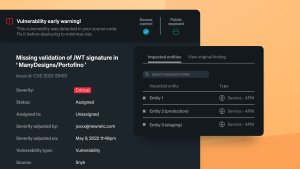Peak shopping season is right around the corner. Black Friday. Cyber Monday. Holiday rushes. For retailers, these moments represent the difference between record-breaking quarters and costly outages that drive customers straight to competitors.
Traditional monitoring approaches with fragmented tools, reactive alerts, and disconnected data can't keep pace with modern retail complexity. Today's customer journeys span mobile apps, websites, physical stores, payment processors, inventory systems, and third-party APIs – trying to monitor and optimize your customers’ experiences without a unified intelligent observability solution is nearly impossible. Even a single slow page load or payment gateway hiccup can cost you thousands in lost conversions — 40% of shoppers abandon websites that take longer than 3 seconds to load.
Retailers who thrive during peak periods are connecting every layer of their stack to actual business outcomes. They see which technical issues impact revenue. They understand mobile experiences down to every tap and swipe. And they model entire business processes, not just infrastructure metrics.
This is the evolution from traditional observability to intelligent observability built specifically for retail.
The foundation: Full-stack observability for retail complexity
Modern retail architectures are complex, built out from a maze of microservices, containerized applications, cloud infrastructure, legacy systems, and third-party integrations all working together to deliver a single checkout experience. Application Performance Monitoring (APM) serves as the foundation of retail observability, providing deep instrumentation across your entire application stack.
New Relic APM tracks every transaction from the moment a customer searches for a product to the millisecond that their payment processes. It’s about understanding exactly which service, database query, or external API call is causing a slowdown during your high traffic moments.
For retail specifically, this means:
- Transaction tracing across distributed systems: When a customer clicks "Buy Now," APM traces out the complete path, showing you where latency creeps in, whether it's a database query taking 3 seconds instead of 300ms, or a payment API timing out.
- Error tracking with business context: A 404 on a blog post is annoying. A 500 error during checkout is revenue loss. APM contextualizes errors with business impact.
- Dependency mapping: APM discovers and maps connections to payment processors, inventory systems, and shipping APIs, so when a third-party service degrades, you know immediately which customer experiences are affected.
Combined with Infrastructure Monitoring for traffic spikes, Log Management for debugging, and Synthetic Monitoring to test critical flows 24/7, New Relic’s unified platform ensures every signal is connected and every data point correlated.
Domino's uses New Relic to achieve 99.6% availability across their ordering systems. During peak moments, when orders surge 10x, their teams can instantly identify bottlenecks and resolve issues before customers even notice.
The mobile imperative: Why 60% of your revenue demands better visibility
Here's a stat that should change how you think about observability: mobile e-commerce will account for 60% of total retail sales in 2025. More than half your revenue is happening on smartphones.
Yet mobile remains one of the hardest environments to monitor. Mobile apps operate in wildly inconsistent conditions: flaky cellular networks, battery constraints, hundreds of device types, and a multitude of operating system versions. A checkout flow that works perfectly on iPhone 17 might crash on Android 16.
Traditional monitoring approaches may fall short. Crash reports can tell you that something broke, but not always why. Logs show any backend errors, but they miss what the user actually saw. As a result, you're left piecing together fragments of data, trying to reproduce issues you can't fully identify.
Mobile Real User Monitoring (MRUM) provides real-time visibility into actual user experiences across iOS and Android, tracking app launch time, screen load performance, HTTP request latency, and crash rates, all segmented by device type, OS version, carrier, and geography.
But the real breakthrough comes from understanding the why behind the numbers.
Introducing Mobile Session Replay: See what your customers see
At New Relic Now 2025, we announced Mobile Session Replay. This fundamentally changes how teams troubleshoot mobile app issues. Instead of guessing what happened based on logs and crash reports, you can watch a visual replay of the actual user session. Every tap, swipe, scroll, and response, exactly as your customer experienced it.
If an error occurs, you can see what the user was doing before that happened, the exact interaction that triggered the problem, what happened after, and see it in the context of correlated backend data showing which service or API failed.
What makes Mobile Session Replay different
Privacy-first by design: No personally identifiable information (PII) is collected out-of-the-box. Sensitive data is automatically masked, and masking settings can be updated server-side. This is critical for maintaining strong security protocols across all app versions.
Cost-effective error-driven sampling: Instead of recording a blanket percentage of all sessions, Mobile Session Replay uses intelligent error-driven sampling. It automatically captures sessions where errors occurred. These are the sessions your engineering team needs to see.
Full-stack correlation: Replays are automatically synced to logs, breadcrumbs, and backend APM data. You can view a replay in Transaction 360 alongside data from your entire stack, showing you exactly how frontend issues connect to backend failures.
Companies using session replay tools are seeing significant improvements in conversion rates due to significantly faster issue resolution. When you can watch a customer struggle through a broken checkout flow and immediately identify the issue, you can fix it in minutes.
Business observability: Connect technical performance to revenue impact
There's an important gap that many observability platforms don't address. While engineers see CPU spikes and error rates, business leaders see revenue drops and customer churn. Connecting those two perspectives is too often manual, time-consuming, and in many cases happens too late.
New Relic’s Pathpoint solves this by providing business observability, which is a way to model your critical business processes and connect them directly to the underlying technical systems. Instead of asking, "What's broken?" you can ask, "Which part of my business is impacted?"
How Pathpoint works for retail
Using Pathpoint's no-code interface, you visually model your critical business flows. For example, a typical e-commerce purchase journey might include: Product Discovery → Cart Management → Checkout → Payment Processing → Order Confirmation → Fulfillment.
For each stage, you map relevant telemetry signals: APM transactions, infrastructure metrics, RUM data, synthetic checks, and third-party API monitoring. Pathpoint aggregates these signals to show real-time health status for each stage.
Then if checkout slows down during Black Friday, you see business-focused alerts such as "Checkout stage degraded. Estimated impact: $15,000/hour in lost conversions." This changes how you prioritize incidents. High-impact outages can cost $2 million per hour. Pathpoint helps you focus engineering resources on the issues that threaten revenue most.
Why this matters to you
Retail has unique high-stakes moments. Black Friday traffic can spike 10x normal volume. A payment gateway issue during Cyber Monday can block thousands of transactions. To help mitigate potential issues, Pathpoint lets you:
- Track KPIs: conversion rates, cart abandonment, and order completion alongside technical metrics.
- Use journey playback to understand past incidents and prevent future occurrences.
- Monitor third-party dependencies, including payment processors, shipping APIs, and inventory systems.
- Share a common view and language with executives, product managers, and engineers.
Mercado Libre, one of Latin America's largest e-commerce platforms, uses New Relic to maintain a zero-error rate during peak traffic. By connecting system performance to business outcomes, their teams can instantly identify and resolve issues before they impact conversion rates.
What the data tells us: Retail's observability evolution
Our 2025 State of Observability for Retail report reveals critical trends shaping how retailers adopt observability. Key findings include:
- Customer experience management: 27% of respondents noted that managing the customer experience is a motivating factor. Retailers understand that outages directly lead to lost revenue and customer churn.
- Artificial intelligence (AI): The adoption of AI technologies is the most prominent driver for observability in retail, with 50% of respondents citing it as a motivating factor.
The data confirms what leading retailers already know: observability is about driving business outcomes. When you can connect system performance to customer satisfaction, conversion rates, and revenue, observability becomes an advantage.
Download the State of Observability for Retail report to see detailed analysis and industry benchmarks.
Bringing it all together: The modern retail observability stack
Modern retail success requires more than isolated monitoring tools. It demands an intelligent observability platform that connects every signal, from infrastructure metrics to business KPIs, into a single source of truth.
Foundation layer: APM and infrastructure monitoring with deep instrumentation, automatic dependency mapping, and real-time alerting.
Digital experience layer: Browser RUM, Mobile RUM, Mobile Session Replay (NEW), Synthetics, and automatic user journey tracking.
Business intelligence layer: Pathpoint for no-code business process modeling, real-time health status, KPI tracking, and incident prioritization based on financial impact.
Advanced intelligence layer: AI-powered anomaly detection, automated root cause analysis, AI-driven session summaries, and intelligent alerting focused on business impact.
Preparing for peak season: Your action checklist
With the holiday shopping season on the horizon and New Years sales soon to follow, here's how to ensure your observability strategy is ready:
- Establish your baseline: Use APM to understand current performance and identify your slowest transactions and highest-error endpoints.
- Prioritize mobile experiences: Implement Mobile RUM and enable Mobile Session Replay to capture error-driven sessions.
- Model your critical business processes: Use Pathpoint to visualize your purchase journey end-to-end and establish KPI baselines.
- Prepare for traffic spikes: Run load tests, set up intelligent alerting based on business impact, and create runbooks for peak-season scenarios.
- Enable team collaboration: Give stakeholders access to Pathpoint dashboards and ensure all teams can access session replays.
Retail demands intelligent observability. Connect every technical signal to business outcomes, understand mobile experiences at the deepest level, and use intelligent insights to prevent issues before they impact customers.
With New Relic's Intelligent Observability Platform, including newly launched Mobile Session Replay and enhanced Pathpoint business observability, you have everything needed to deliver flawless digital experiences that drive revenue and customer loyalty.
Next steps
- Explore New Relic for Retail
- Discover Mobile Session Replay
- Launch Business Observability withPathpoint
- Download the 2025 Retail Report - Get industry benchmarks and insights
The views expressed on this blog are those of the author and do not necessarily reflect the views of New Relic. Any solutions offered by the author are environment-specific and not part of the commercial solutions or support offered by New Relic. Please join us exclusively at the Explorers Hub (discuss.newrelic.com) for questions and support related to this blog post. This blog may contain links to content on third-party sites. By providing such links, New Relic does not adopt, guarantee, approve or endorse the information, views or products available on such sites.



